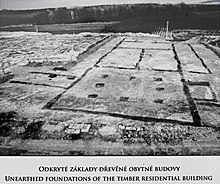Roman fort, Mušov
 | |
| Location | Moravia, Czech Republic |
|---|---|
| Region | Marcomania |
| Type | Castrum |
| History | |
| Periods | Roman Empire |



Roman fortress in Mušov (Eβυρον ?? in Ptolemy) was a Roman army camp on the Dyje-Svratka-Jihlava confluence in the Marcomania (now Moravia-Czech Republic) province prepared as the capital of the proposed Marcomania province, with mor e thausend people.[1][2] Its remains are situated in Moravia halfway between Brno (18 km) and Vienna (86 km).
History
Roman fortress in Mušov originated as a Roman army camp. Its name is unknown (probably, but unsure: Eburon). ... made it his base of operations in the campaigns against Maroboduus (Marbod). So far the most important in the Europe-wide context remains the unique site encompassing large variety of evidences of the period of the Marcomannic Wars (166-180 AD) - the central military base on the hill Hradisko (Hillfort) at Mušov (now cadastral area of Pasohlávky). It was built by the Marcus Aurelius' soldiers deep inside the enemy territory, roughly 86 km to the north of the antique Vindobona (today Vienna). The base covers flat minor hilltop, superelevated by 50 m above surrounding terrain, and its southern mild slopes, on the banks of the river Dyje (Thaya). From this strategically situated location was possible to control and manage crossings of river and overland routes at the confluence of the rivers Svratka, Svitava and Dyje (Thaya) as well as surrounding areas along the rivers, densely populated by the Germanic tribes of Marcomanii..
Even in Roman times it had a history as a trading center for amber(in analogy as Carnuntum), brought from the north totraders who sold it in Italy; the main arm of the Amber Road crossed the Danube at Carnuntum and continue on the left...of Dyje. Marcus Aurelius resided there for short time in the operatoion time, shoirtly before hir deth (180) - during the war against the Marcomanni, and wrote part of his Meditations there. During the Barbarian Invasions (reocuppy of the teritory - "Eburon" was eventually abandoned and used as a cemetery and source of building material for building projects elsewhere. Eventually, its remains were covered by decaying plant material.
Civilian city

The remains of the civilian city extend around the village . The plant arround the superior citadelle was in fact nearly 5 km2 and simply fortified setled by densely populated by the Germanic tribes of Markomanii.
Balneum
The inner build-up area of the Roman fortress at Hradisko was uncovered in very limited scale so far. Yet between the years 1926 and 1928 was uncovered unique evidences of antique architecture in the north parts of fortified area by archeologist Gnirs and suported by president Masaryk. Back then discovered enclosure, consisting of residential building with four rooms and baths, considering the war conditions, could be interpreted as luxury residential complex, some sort of ad hoc residence for the highest representatives of military authorities and comandants. Smaller scales of the baths implies rather private use, but there were all necessary rooms including cold and hot water. Baths determined for ordinary Roman soldiers will be at Hilfort (Hradisko) perhaps found in the future.
Military camps
In the close surrounding was discovered more than 12 short time roman military camps. In the seasonal operations (179) was setled there more than 50 000Legionaire, mostly from the X. leggio - Pia at
Workshop
On the open area among the buildings were uncovered simple round kilns and one sizable waste pit. This instalation served as workshop quarter, specializace among others to reparations and perhaps simple production of the Roman military equipment and weaponry. This evidence support an idea that inside the fortified area operated smaller numbers of civilian personnel under protection of the Roman army. Their sustenance dependen on contracts with the Roman army and for that they followed them even in the time of war into the hostile territory
References
- ^ Sutter Fichtner, Paula (2009). Historical Dictionary of Austria. Scarecrow Press. p. 54–55. ISBN 9780810863101.
- ^ Beattie, Andrew (2010). The Danube: A Cultural History. Oxford University Press. p. 109. ISBN 9780199768356.
This article incorporates text from a publication now in the public domain: Chisholm, Hugh, ed. (1911). Encyclopædia Britannica (11th ed.). Cambridge University Press. {{cite encyclopedia}}: Missing or empty |title= (help)

